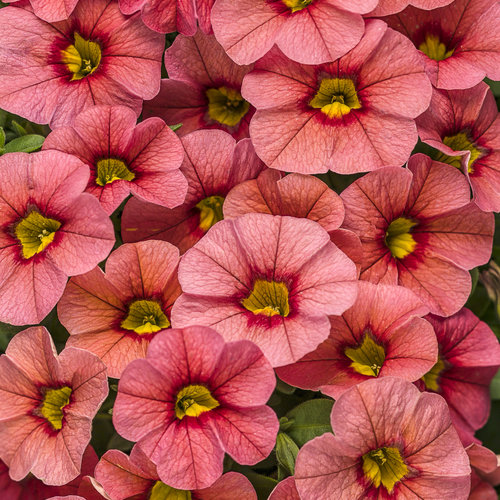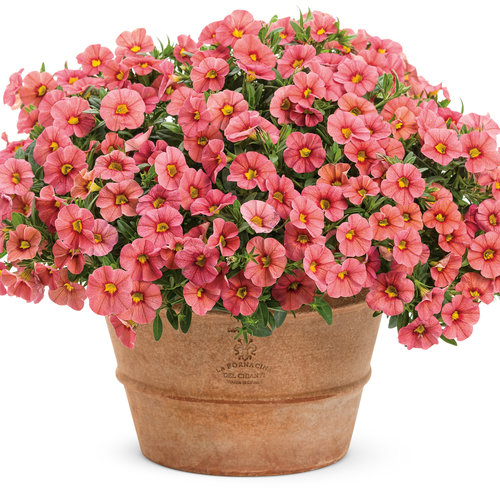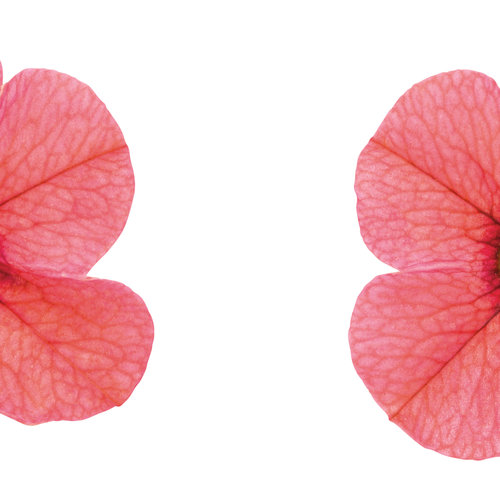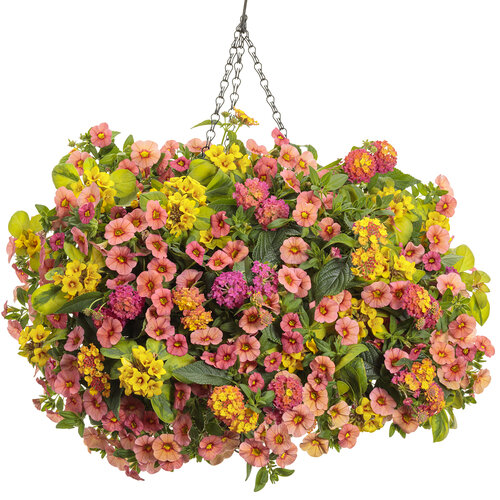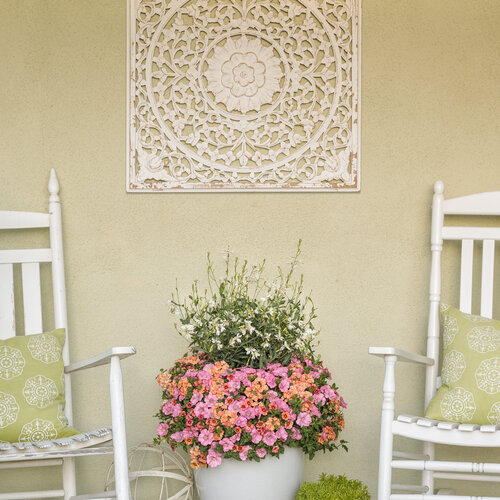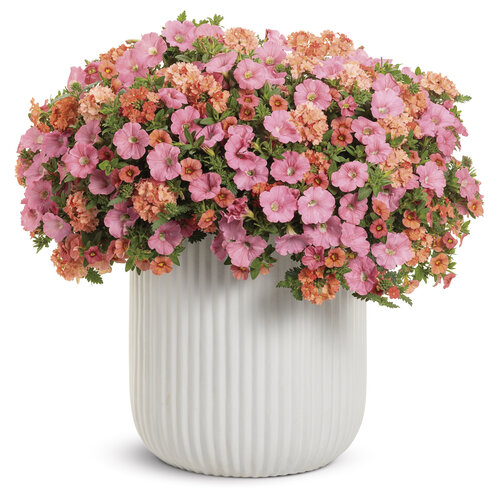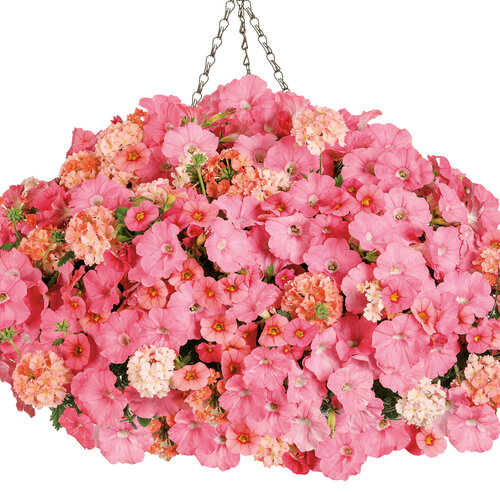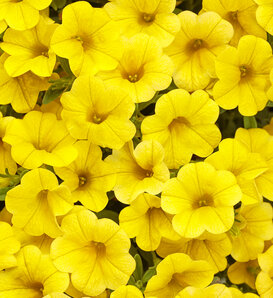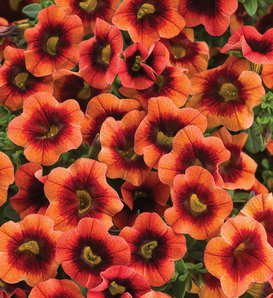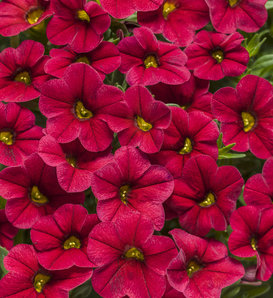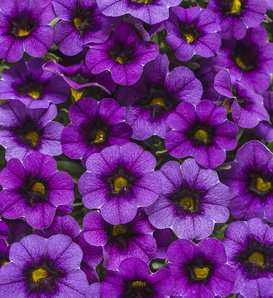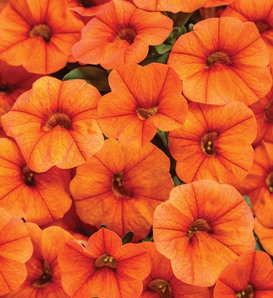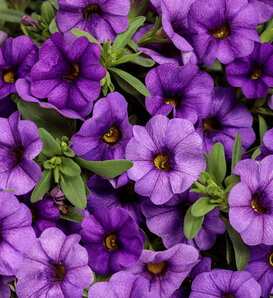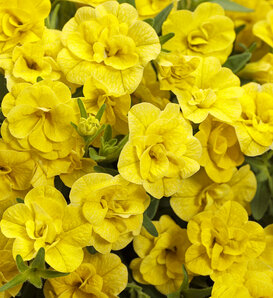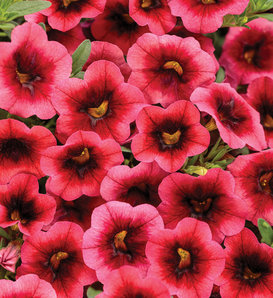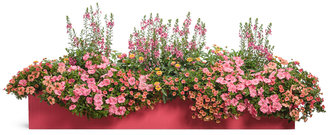I love this plant. I've never grown it before. I had it in a pot with Vincas, PW sweet potato vine and a geranium. It was getting a bit squished so I put it in its own pot. It was gorgeous...I say "was" because a deer nibbled on it. Grrr. Live and learn, right? So now it is on my porch where hopefully the 4-legged beasts cannot get to it. The color variations in the little flowers give great interest and it is a lovely spot of color and flowers among my other potted plants of coleus. I saw someone in Oklahoma planted in the ground with success. I may try that next spring. I'd try it now but husband said NO MORE BUYING PLANTS. :( FYI, I live in East Texas HEAT and humidity.
Superbells® Coralina Calibrachoa hybrid
- Part Sun to Sun
- Spring
- Summer
- Fall
-
Details
6 - 12 Inches8 - 12 Inches12 - 24 Inches15cm - 30cm20cm - 30cm30cm - 61cmFeatures
Abundant, small petunia-like flowers all season on cascading growth; low maintenance.
Continuous Bloom or RebloomerLong BloomingFall InterestHeat TolerantDeadheading Not NecessaryAttracts:HummingbirdsCharacteristics
Plant Type:AnnualHeight Category:ShortGarden Height:6 - 12 Inches 15cm - 30cmTrails Up To:18 Inches 46cmSpacing:8 - 12 Inches 20cm - 30cmSpread:12 - 24 Inches 30cm - 61cmFlower Colors:PinkFlower Colors:RedFlower Shade:coral-pinkFoliage Colors:GreenFoliage Shade:GreenHabit:Mounding TrailingContainer Role:SpillerPlant Needs
Light Requirement:Part Sun to SunThe optimum amount of sun or shade each plant needs to thrive: Full Sun (6+ hours), Part Sun (4-6 hours), Full Shade (up to 4 hours).
Maintenance Category:EasyBloom Time:Planting To Hard FrostHardiness Zones:9a, 9b, 10a, 10b, 11a, 11bWater Category:AverageNeeds Good DrainageUses:ContainerUses Notes:Calibrachoa do not like to have constantly damp soil. They will do well in the ground only with good drainage. For most gardeners containers are the best use for Calibrachoa.
Maintenance Notes:When planting Calibrachoa I often give the plants a slight trim, using a sharp pair of scissors or pruning shears. While not a necessary step, it will increase branching and may help your plants look even fuller.
Calibrachoa are usually easiest to grow in containers. If the roots are kept too wet it can lead to root rot diseases. In containers, allow the top of the soil to dry before watering again. If your plant is wilting even though the soil is still damp you likely have a root rot problem.
Calibrachoa can be fantastic in-ground plants, but only if they are planted in well-drained soil. Raised beds would be a good choice for planting Calibrachoa in the landscape. In the ground they shouldn't need much additional water unless conditions are very dry. Proper watering is key to growing good Calibrachoa.
The plants are low-maintenance with no deadheading needed. They will do best if fertilized on a regular basis. Calibrachoa can be sensitive to both high and low pH. If your plants have been growing for a while and then begin to look a bit tired and not so good there are several things to try. If the foliage is yellow there are two possible causes. If you haven't been fertilizing regularly they could simply be hungry and in need of fertilizer. Feed them using a well-balanced (look for something with an n-p-k ratio near 24-12-17) water soluble fertilizer. If you have been fertilizing regularly with a well-balanced fertilizer and the foliage is still turning yellow, it is probably because the pH range in your soil has gotten a bit high or low. The most common impact of this is that Iron can no longer be taken up by the plant, even if it is available in the soil.
The common form of Iron used in fertilizer is sensitive to pH changes. If you think pH is your problem you can either try to lower (or raise) the pH or you can simply apply Chelated Iron, which is available at a wider pH range and should help your plants turn green again. You may also be able to find Iron in a foliar spray (which means you spray it on the foliage rather than applying it to the soil) which can also help your plant turn nice and green again. Stop by your favorite garden center and they should be able to help you choose a product to use. Or use our Proven Winners Water Soluble fertilizer, which has the chelated iron.
As the season goes on the plants can sometimes just start to look open and not as good. This can happen even if they are being watered and fertilized correctly. Fortunately this is very simple to fix. Grab a sharp pair of scissors or pruning shears and give the plants an all over trim. This will cause them to branch out more and should stimulate new growth and flowering, especially if you fertilize right after trimming them back. Just like your hair looks a lot better after a trim, your plants often will too. You will sacrifice flowers for a few days, but the plants should shortly come back flowering more than ever. I will usually give my Superbells a trim back in late July or early August. Should your plants have a few unruly stems that are longer than everything else or sticking our oddly, you can trim these stems back at any time. Calibrachoa are very forgiving when it comes to trimming.
An application of fertilizer or compost on garden beds and regular fertilization of plants in pots will help ensure the best possible performance.
Woo-hoo! There is nothing more super than Superbells. If there was a word that meant extra, extra super it still wouldn't be as super as we are. Calibrachoas are a new type of plants that sort of look like little Petunias, which makes sense seeing as we're related. Only Superbells aren't sticky, perk right back up after it rains, and stay compact and bushy even when we are stressed.
Superbells are Proven Winners' newest Calibrachoas. We're the ones covered with hundreds of flowers from early spring all the way through those first light frosts. Just 6 - 10 inches tall, our long, long, trailing branches cascade over the sides of hanging baskets and other containers, and spread over flower beds. Hummingbirds are cuckoo about us.
Vigor, heat tolerance and resistance to disease are traits we all share. So is being an annual except in zones 9 - 11. You don't have to deadhead old flowers or pinch back stems. Water only when the top of the soil feels dry. Too much water makes our roots rot (Ick). Full sun. Fertilize once a month. How extra double super easy is that?
Superbells® Coralina Calibrachoa hybrid 'INCALMIABE' USPP 28,036, Can 5,556 -
5 Reviews
5441321Browse reviews from people who have grown this plant.-
Michelle Boatright, Texas, United States, 1 year ago
-
Impressed is an understatement. I live in zone 7a. I planted two of these plants in my west facing flowerbed, straight into the ground. They not only managed an in-ground planting, the crazy heat and drought like summer and looked phenomenal.... they are now returning after no special winter care! Leaves are starting to make their way out of old stems!! We will see how things progress, but for what I thought would be a temporary plant, it sure is leaving a statement.
Amber Hampton, Oklahoma, United States, 1 year ago -
Favorite superbells color, only bought one last year and just picked up 4 more this year. Absolutely gorgeous and accents my purple theme perfectly. Healthy and hardy plant. My son accidently knocked over a stack of keystone blocks on top of it and I thought it was a goner. All the branches were smashed or broken. I trimed it up and it came right back. I can't wait to plant more. Enjoy.
JULIE WARD, California, United States, 3 years ago -
Picked up one of these in April. Already grown 50% by mid May in container with 2 other PW plants. The blooms on Coralina are huge for a callie and of a brilliant color. Slight variation in flower color from melon to almost orange but mostly the coral color. Unlike some callies, this variety is a sturdy version, similar in structure to the Lemon Slice callie offered by PW. So far my Coralina is more a mounder than a trailer and it is a bit more upright plant but for my needs this is preferable. Planted in mid grade soil and gets only water and fertilizer yet still performing well in morning/early afternoon sun. Still early but I will wager this guy will weather the harsh Washington summer and continue to impress. I recommend Coralina and look forward to seeing it perform in 2017. Matthew Lamb Frederick, MD
Matthew Lamb, Maryland, United States, 7 years ago -
I just got one of this color. It looks fantastic with my Honey petunias. Beautiful color to blend with other plants in yellow and oranges.
Sharon Ebel, Wisconsin, United States, 8 years ago
41 More colors
16 Recipes
13 More Recipes- Acapulco Sun - uprightRecipe
What you'll need:
-
2
-
2
-
2
-
What you'll need:
-
1
-
2
-
2
-
2
-
-



